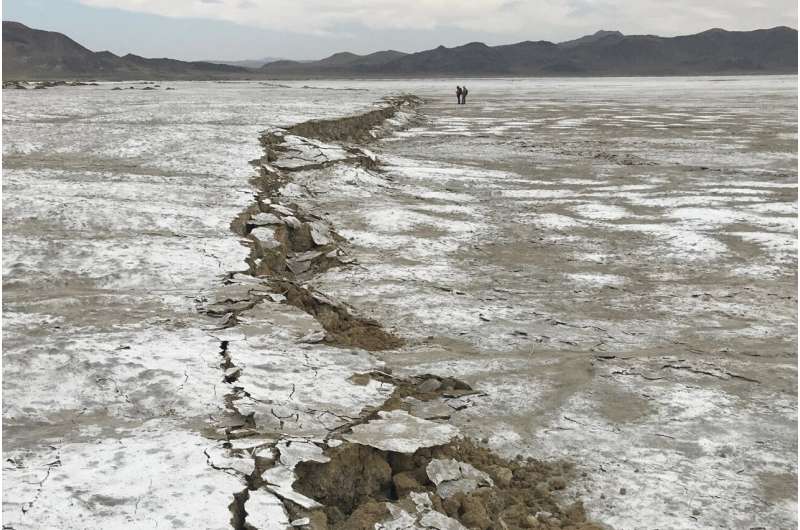Geologists make measurements of a fault rupture the day after a magnitude 7.1 earthquake struck near Ridgecrest, Calif. Credit: Ben Brooks, USGS
On the morning of July 4, 2019, a series of very small earthquakes began to rumble in the Mojave Desert, not far from the southern California town of Ridgecrest.
No one at the time knew these were foreshocks that would soon be followed by two of the biggest earthquakes to strike California in more than 20 years. A magnitude-6.4 earthquake rattled the region on July 4, hurling bottles from store shelves, breaking windows and water mains, cracking a highway and prompting evacuations.
Two days and hundreds of small quakes later, a magnitude 7.1 earthquake (nearly 11 times more powerful) struck on a different fault in the same area, leaving behind fires, leaking water and gas lines, and cracked buildings and roads and forcing the evacuation of a Naval weapons facility larger than Rhode Island.
The U.S. Geological Survey reports roughly half of the biggest earthquakes on record in California have been preceded by foreshocks. Worldwide, there's about a 6 percent chance that any given earthquake will turn out to be a foreshock followed by a bigger quake within three days, although that likelihood diminishes as the time from the initial event increases.
But foreshocks are only recognized in hindsight. "A foreshock is simply an earthquake followed by a larger earthquake—the mainshock," explained Paul Segall, professor of geophysics at Stanford University's School of Earth, Energy & Environmental Sciences (Stanford Earth). Usually, for a preceding quake to be considered a foreshock, seismologists also look for the epicenter to be in the same general area as the mainshock—at a distance no more than a few times the length of the fault section that moved during the mainshock.
Because foreshocks precede larger quakes, growing more frequent as the mainshock approaches, they have long presented the tantalizing prospect of warning of potentially damaging earthquakes. "If we could somehow determine that a given quake was a foreshock before the mainshock arrives, that could be extremely useful," Segall said.
Foreshocks arise from rough faults
Scientists for decades have sought to understand the physical processes that drive foreshocks, and why some earthquake sequences have them while others don't. One leading theory proposes that foreshocks result from an acceleration of slipping movements along a fault. This movement, known as aseismic slip, triggers small earthquakes as it extends across ever-larger areas of the fault and speeds up.
"The alternative idea is of a cascade of small earthquakes without aseismic slip," said Segall, who is the Cecil H. and Ida M. Green Professor in Geophysics. "Earthquakes redistribute stress within the Earth. In areas where stress increases, it can trigger other quakes. This growing cascade eventually triggers an event that grows into the mainshock."
Recent research by Segall and seismologist Camilla Cattania in the Journal of Geophysical Research: Solid Earth suggests foreshocks are in fact driven by feedback between the two. "We found that both mechanisms—aseismic slip and stress redistribution by small earthquakes—are at play during foreshock sequences, and they reinforce each other. A complex fault geometry allows simultaneous aseismic slip and foreshocks," said Cattania, an assistant professor in MIT's Department of Earth, Atmospheric and Planetary Sciences who worked on the research as a research scientist at Stanford.
Like many natural systems, faults are fractal, meaning they are irregular at all scales. "When the two sides of a rough fault slide past each other, some parts of the fault sides are pressed together, forming stuck patches," Cattania explained. "Foreshocks represent the rupture of these stuck patches." These ruptures then increase stress in surrounding areas, gradually "unpinning" the fault and causing aseismic slip to accelerate. "Faster aseismic slip, in turn, stresses nearby seismic patches and triggers more foreshocks. This positive feedback causes an expansion of the slipping region and increasingly frequent foreshocks, leading up to the mainshock," she said.
According to Cattania, this means fault roughness is therefore the underlying cause of the feedback between foreshocks and aseismic slip. She said, "Since all faults are rough, seismic and aseismic slip are likely to coexist during most foreshock sequences. The classical mechanisms proposed for foreshock—either driven by aseismic slip or a completely seismic cascade—each capture part of the process, but they are not mutually exclusive."
Simulating earthquake sequences
Evidence for the idea of foreshocks resulting from a combination of accelerating aseismic slip and cascades of small earthquakes comes from computer modeling. Cattania and Segall set up numerical simulations of seismic cycles on rough faults, with geometry consistent with data from the field and laboratory.
The team's simulations showed foreshocks accelerating leading up to the mainshock, consistent with the patterns seen in the averages of data from real-world foreshocks—a testament to the model's accuracy. In the future, it's possible that the model's predictions could be used to glean new insights about foreshock sequences from existing datasets and uncover previously missed or misinterpreted instances of aseismic slip. "Our results provide a physical interpretation for foreshocks," Cattania said. "But much work remains to be done before this knowledge can be translated into forecasting."
More information: Camilla Cattania et al, Precursory Slow Slip and Foreshocks on Rough Faults, Journal of Geophysical Research: Solid Earth (2021). DOI: 10.1029/2020JB020430
Journal information: Journal of Geophysical Research: Solid Earth
Provided by Stanford University
























